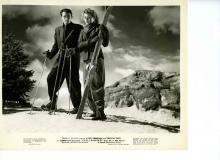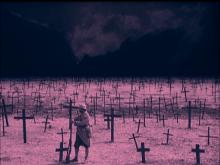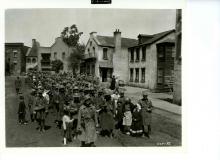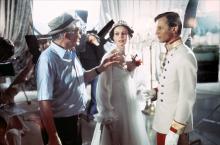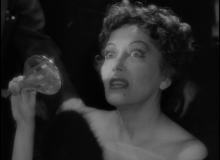This essay on Alfred Hitchcock's Spellbound were written by UW Undergraduate student Blake Davenport. Spellbound will screen on Sunday, December 7 at 2 p.m. in the Chazen Museum of Art.
By Blake Davenport
“I like stories with lots of psychology” – Alfred Hitchcock
Although Hitchcock will forever live on through his masterful films, the public persona he cultivated during his more than 50 years in cinema undoubtedly opened up a realm of discourse that propelled the director to legendary status. From villainous misogynist to eccentric oddball, opinions on the auteur are dizzying in number and largely compounded by the fact that Hitch was notoriously misleading in interviews.
One aspect of his persona that Hitchcock would gladly reveal was his love of the good practical joke. These included: dyeing every course of one of his dinner parties blue; sending 400 smoked herrings to one of his stars; and even handcuffing his leads together for hours during the filming of The 39 Steps. Clearly, this was a man who took a certain delight in testing the psychological limits of those around him both in his work and private life. Invariably, Hitchcock’s penchant for psychological play becomes dramatically grounded in the 1940s, when Freudianism was very much in vogue, in such films as Rebecca (1940) and Shadow of a Doubt (1943). In 1945, Hitchcock would direct his first film narratively centered on psychoanalysis, the romantic thriller Spellbound.
Top-billed by Ingrid Bergman and Gregory Peck, Spellbound weaves together the intricate threads of whodunit murder and psychological romance in an effective and suspenseful, if at times taxing, narrative. Bergman stars as Dr. Constance Peterson, an up and coming psychiatrist and the only female doctor at Green Manors mental hospital. Although Constance is charming, intelligent and essentially a great catch, her fellow doctors tease her for her overly clinical attitude towards patients and life. One of her fellow doctors even attempts to melt her façade with romance, which she notably rebuffs.
With the arrival of young and brilliant new hospital director Dr. Edwardes (Peck), Constance soon finds her world turned upside down, as the two immediately develop a strong attraction to each other. Unfortunately for the happy couple, this is a Hitchcock film and things cant be so cut and dry. Constance soon discovers that Edwardes is not the esteemed psychologist at all, but a deeply disturbed and amnesiac patient of the real Edwardes, who may or may not have been murdered by his pretender. As the police soon pick up on the mysterious “John Brown’s” trail, Constance throws all caution to the wind and the two set out in an attempt to uncover the truth behind Edwardes death and the root of John’s psychosis.
While Spellbound might not top the list of favorite Hitchcock films for cinephiles, there are many elements throughout that make the film a worthwhile treat for admirers of the esteemed director. On a certain level the character roles are quite demanding of its two leads, as Peck and Bergman have to juggle the duality of romance and patient-doctor relationship. However, the two characters anchor the film beautifully and create a passionate web of love and psychology that is made even more interesting by the rumor that Bergman and Peck carried on an affair during filming.
Perhaps the most impressive aspects of Spellbound lie in some of the technical decisions that were made as well. Bernard Herrmann, who became Hitchcock’s usual musical composer 10 years after Spellbound was released, famously declined to work on the film, which fortunately paved the way for Miklos Rozsa’s beautifully sweeping score. Ever the perfectionist, Hitchcock complained that the music “got in the way of his direction”, but Rozsa’s work is perfect for the tone of the film and well deserving of one of only seven Academy Awards won for a Hitchcock film.
And then there’s the famous dream sequence. As a major plot point in the film revolves around Constance and her mentor attempting to analyze John’s dreams, Hitchcock had his producer David O. Selznick bring in none other than Salvador Dali to design the entire sequence. The result? A stunning 2-minute (cut from 20!) twilight-zone journey, abound with gigantic blinking eyes, men with no faces and a variety of other symbols which unfortunately went right over this film major’s head. Nonetheless, the sequence is a must see quite simply for the visual pleasure, but also as one of the first filmic illustrations of psychoanalysis on screen!
Spellbound is not without its problems. In spending so much time developing the psychoanalytic framework of the film, the suspense plotline ultimately falls short, as it never really seems that our couple is in any pressing danger. Disregarding narrative qualms however, Spellbound takes the audience on a highly entertaining adventure that is a must see for anyone looking to gleam a little bit more about the psychology of Hitchcock.

